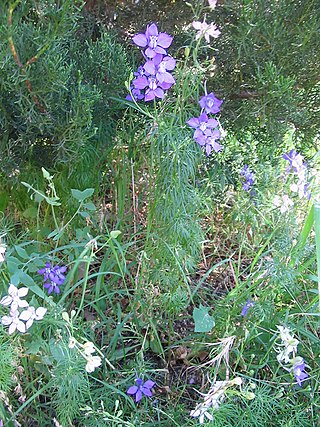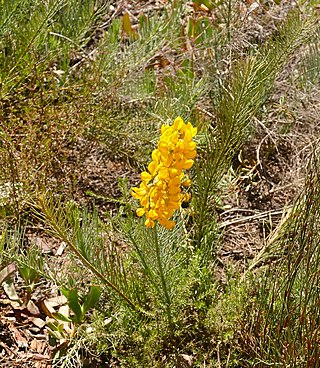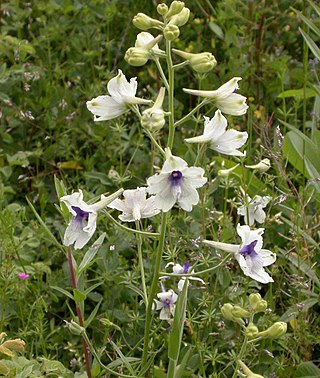
Delphinium is a genus of about 300 species of annual and perennial flowering plants in the family Ranunculaceae, native throughout the Northern Hemisphere and also on the high mountains of tropical Africa. The genus was erected by Carl Linnaeus.

Consolida ajacis is an annual flowering plant of the family Ranunculaceae native to Eurasia. It is widespread in other areas, including much of North America, where it is an introduced species. It is frequently grown in gardens as an ornamental for its spikes of blue, pink or white flowers. It may reach a meter in height. Since the aerial parts and seeds of C. ajacis have been found to contain diterpenoid alkaloids, including the highly toxic methyllycaconitine, the plants should be considered as poisonous.

Methyllycaconitine (MLA) is a diterpenoid alkaloid found in many species of Delphinium (larkspurs). In common with many other diterpenoid alkaloids, it is toxic to animals, although the acute toxicity varies with species. Early research was focused on identifying, and characterizing the properties of methyllycaconitine as one of the principal toxins in larkspurs responsible for livestock poisoning in the mountain rangelands of North America. Methyllycaconitine has been explored as a possible therapeutic agent for the treatment of spastic paralysis, and it has been shown to have insecticidal properties. Most recently, it has become an important molecular probe for studying the pharmacology of the nicotinic acetylcholine receptor.

Delphinium nudicaule, known by the common names canyon larkspur, red larkspur, orange larkspur, and canyon delphinium, is a flowering herbaceous perennial plant in the buttercup family Ranunculaceae. It is native to low-elevation canyons and slopes, foothills, and mountain ranges of California, US, from the Sierra Nevada to the California Coast Ranges, and of Oregon. It grows below 6,500 feet (2,000 m).

Lebeckia is a genus of plants in the family Fabaceae native to the fynbos of South Africa. Several members of Lebeckia were recently transferred to other genera. Members of Lebeckia are known to produce pyrrolizidine alkaloids, including ammodendrine, lebeckianine, and lupanine. The genus was named by Carl Thunberg for his student Heinrich Julius Lebeck.

Delphinium cardinale is a species of larkspur known by the common names scarlet larkspur and cardinal larkspur. This wildflower is native to California and Baja California, where it grows on coastal, inland, and desert chaparral slopes, such as the Colorado Desert, and the Peninsular and Transverse Ranges. The presence of diterpenoid alkaloids, probably including the highly toxic methyllycaconitine, in above-ground parts of D. cardinale means that they are likely to be toxic if ingested.

Crotalarieae is a tribe of flowering plants belonging to the family Fabaceae. It includes rooibos (Aspalathus linearis), harvested for sale as a tisane.

Delphinine is a toxic diterpenoid alkaloid found in plants from the Delphinium (larkspur) and Atragene genera, both in the family Ranunculaceae. Delphinine is the principal alkaloid found in Delphinium staphisagria seeds – at one time, under the name stavesacre, a very well known herbal treatment for body lice. It is related in structure and has similar effects to aconitine, acting as an allosteric modulator of voltage gated sodium channels, and producing low blood pressure, slowed heart rate and abnormal heart rhythms. These effects make it highly poisonous. While it has been used in some alternative medicines, most of the medical community does not recommend using it due to its extreme toxicity.

The tribe Podalyrieae is one of the subdivisions of the plant family Fabaceae.

The tribe Sophoreae is one of the subdivisions of the plant family Fabaceae. Traditionally this tribe has been used as a wastebasket taxon to accommodate genera of Faboideae which exhibit actinomorphic, rather than zygomorphic floral symmetry and/or incompletely differentiated petals and free stamens. Various morphological and molecular analyses indicated that Sophoreae as traditionally circumscribed was polyphyletic. This led to a re-circumscription of Sophoreae, which resulted in the transfer of many genera to other tribes. This also necessitated the inclusion of two former tribes, Euchresteae and Thermopsideae, in the new definition of Sophoreae. Tribe Sophoreae, as currently circumscribed, consistently forms a monophyletic clade in molecular phylogenetic analyses. The Sophoreae arose 40.8 ± 2.4 million years ago.

Delphinium pavonaceum is a species of flowering plant in the buttercup family known by the common name peacock larkspur. It is endemic to Oregon in the United States, where it is limited to the Willamette Valley.

Delphinium tricorne, known by the common names dwarf larkspur or spring larkspur, is a species of flowering plant in the Ranunculaceae (buttercup) family. It is native to the central and eastern United States, where it is the most common Delphinium found.

Delphinium barbeyi is a species of flowering plant in the buttercup family known by the common names subalpine larkspur, tall larkspur, and Barbey's larkspur. It is native to the interior western United States, where it occurs in the states of Arizona, Colorado, New Mexico, Utah, and Wyoming.

Delphinium exaltatum, known by the common name tall larkspur, is a species of flowering plant in the genus Delphinium, part of the buttercup family. Other Delphinium species are also commonly known as tall larkspur, such as Delphinium barbeyi. D. exaltatum is native to the central and eastern United States, where it can be found in Kentucky, Maine, Ohio, Pennsylvania, Maryland, West Virginia, Virginia, North Carolina, Alabama, Tennessee, and Missouri.

Sibiricine is a bioactive isoquinoline alkaloid isolated from Corydalis crispa (Fumariaceae), which is a Bhutanese medicinal plant from the Himalayas.

Delphinium elatum is a species of flowering plant in the buttercup family Ranunculaceae, known by the common name alpine delphinium, guardian lavender, or candle larkspur. It is native to temperate Asia and Europe, it is an erect herbaceous perennial growing to 1.8 m (5.9 ft), with deeply divided leaves. It produces spikes of blue or purple flowers in summer.

The Genistoids are one of the major radiations in the plant family Fabaceae. Members of this phylogenetic clade are primarily found in the Southern hemisphere. Some genera are pollinated by birds. The genistoid clade is consistently resolved as monophyletic in molecular phylogenetic analyses. It is estimated to have arisen 56.4 ± 0.2 million years ago. A node-based definition for the genistoids is: "the MRCA of Poecilanthe parviflora and Lupinus argenteus." One morphological synapomorphy has been tentatively identified: production of quinolizidine alkaloids. Some genera also accumulate pyrrolizidine. A new genus, to be segregated from Clathrotropis, has also been proposed to occupy an undetermined position within the genistoid clade.

Genisteae is a tribe of trees, shrubs and herbaceous plants in the subfamily Faboideae of the family Fabaceae. It includes a number of well-known plants including broom, lupine (lupin), gorse and laburnum.

Delphinium geyeri is a species of plant in the Ranunculaceae family that is often called by the common names plains larkspur and foothills larkspur. It is infamous for causing the deaths of cattle grazing in the spring because it is especially poisonous before it flowers and so it is also called poisonweed by ranchers. It is a medium to tall plant that has very striking blue flowers and is occasionally grown in native plant gardens for this reason. It grows mainly in Wyoming with large population in northern Colorado, northeastern Utah, and parts of Nebraska.

Delphinium menziesii, the Puget Sound larkspur, northern dwarf larkspur, or Menzies' larkspur, is a species of flowering plant in the family Ranunculaceae. It is native to British Columbia, Washington, and Oregon. A perennial reaching 75 cm (30 in), it is hummingbird pollinated.




















